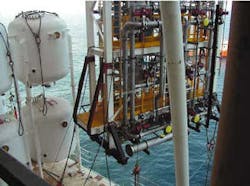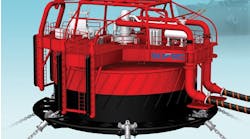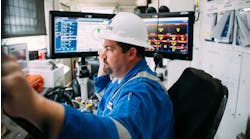OFFSHORE EUROPE: Seawater membrane filtration used to control scale in Syd Arne reservoir
The control of scale in offshore oil fields where filtered seawater is used to maintain reservoir pressure has generally been achieved by using squeeze chemicals and inhibitors injected into the flowline of each water producing well. The control of calcium carbonate scales can be controlled using this method. However, the presence of high levels of barium and strontium in the formation water leads to a second form of scale production: namely barium and strontium sulfate. This will occur when seawater containing sulfate comes into contact with the formation water bearing the strontium and barium ions.
The plan to install a sea waterflood in the Syd Arne reservoir created a potentially severe scaling problem from barium sulfase. Analysis by Amerada Hess reservoir engineers determined there would be severe downhole scale formation problems. The magnitude of the scale problem had the potential to seriously impact the economics of the development.
The production wells were judged at highest risk and in the absence of any preventative measures, downhole scaling due to seawater breakthrough could cause loss of oil production, make sliding sleeves inoperable, and ultimately require wells to be worked over.
Scale prediction
Further analysis showed that the highest potential mass amount of barite scaling would occur at a mixing ratio of 20:80 FW:SW, 880 mg/l at 115° C and 920 mg/l at 60° C, although significant amounts were predicted over much of the mixing range. The higher mass amount precipitated at the lower temperature, representative of process conditions, was due to the lower solubility.
The high scaling tendency meant that the scale would form and deposit rapidly at the point of mixing of the incompatible water types. The scaling reaction would have been difficult to inhibit using chemicals alone. A moderate potential for deposition of strontium sulfate was also identified. However, solutions adapted to control the more serious barium sulfate problem also mitigated against the minor strontium sulfate scale risk.
When untreated seawater meets formation water containing barium, scaling is inevitable. The scale forms immediately downstream of the point of mixing, typically topsides, in the production manifolds and in downstream equipment or in the wellbore. The highest operational risk is that scaling downhole will impact on production.
In the long horizontal S. Arne wells, the potential for scaling was greater than in a conventional homogenous reservoir. Since effective inhibition is costly and technically difficult, every possible alternative was considered in the design and operation of the waterflood system. It was considered financially and environmentally more prudent to remove the problem at source by the reduction of the sulfate content in the injection water.
The use of membrane based sulfate removal technology was identified as the preferred technical option to manage the problem. Weir Westgarth Ltd, the manufacturer for the application of the technology, which was patented by Marathon Oil, was selected as the contractor.
Operational lessons
Weir Westgarth has the benefit of over 40 years experience in desalination processes with over 20 years related to membrane installations. Experience transferred from Marathon Brae and Weir Westgarth's own installations, such as Agip Tiffany, provided considerations during retrofit designs:
- Plant designs should be modular for ease of installation on to an operating production platform.
- Abstracted seawater is best fed to the sulfate reduction package before de-aeration.
- Pipework from the seawater abstraction to module should be in non-ferrous materials to minimize contamination of the membrane system and reduce the module weights.
- Pre-heating of the feed water by the platform cooling systems enhances the efficiency of the plant, but the variations in possible flows. Thus, temperature ranges should be carefully considered during the detailed design phase of the project.
- The membrane system should not be subjected to a reversing of the differential pressure. System surges are difficult to avoid completely and devices to ensure that the product outlet is protected must be incorporated into the design.
- The cleaning system should clean each of the streams with the minimum number of sub-cleaning circuits to minimize off-line time.
- Shock dosing of chlorine to the feed seawater is preferable to continuous dosing.
Dow Marathon process
The use of membrane technology was pioneered by Marathon Oil on the Brae A Field and was designed to utilize a membrane capable of removing specific ions. Unlike reverse osmosis, which rejects all ions, the Dow Filmtec nanofiltration membrane specifically removes sulfate ions.
The process technology requires seawater to be passed through the membrane at 20-30 bar, depending on the temperature of the feed stream. The membranes are capable of reducing seawater sulfate levels from approximately 3000 ppm to less than 40 ppm.
The primary consideration in process design was to agree with Amerada Hess on the level of sulfate required in the product water and also the feed water temperature. The higher the temperature, the lower the pressure needed to maintain the flux rate and the flow per unit area of membrane surface. At higher temperatures the sulfate passage through the membrane and into the product water increases but the energy absorbed decreases.
On the Syd Arne project, Weir Westgarth worked to optimize feed temperature flow by mixing warmed seawater from the platform cooling system outlet with the main injection feed flow. The membrane rejection characteristics being temperature dependant increases the sulfate passage by 100% for every 10° C rise in temperature.
Mixture control
The design conditions for the Syd Arne plant were 10-24° C with three high pressure pumps, each rated for 354 cu m/hr with a 270 meter developed head, along with a 750 kW motor running at 3000 rpm. By controlling the mix ratio of the feed water, the membranes can be operated in a steady state condition with respect to temperature.
This allows a constant feed water pressure to be applied to the membrane ensuring a 75% conversion of seawater feed to low sulfate product water for injection. The residual 25% is discharged overboard and contains the sulfate ions removed from the feed stream. The 75% conversion of feed to product is achieved by a two-stage membrane process with 50% recovery over each stage.
Because of the inter-relationship between temperature and output, the system must be able to vary the applied pressure to the membrane in order to maintain a constant output with changing temperature. The control of the membrane system therefore incorporates analogue loops to ensure that the reject to product ratio stays constant.
Applied pressure varies and the main high pressure pumps are subject to variable back pressure to provide the quantity of water at the required pressure for the changing conditions across the membrane system.
A super duplex steel, Zeron 100, was utilized for the pipework system to eliminate ferrous contamination and reduce the weight of the module. Zeron 100 duplex (UNS32760) pipework allowed reduced pipe diameters and valve sizes because of the high velocity the internal polished surfaces of this super duplex material could utilize without significant pressure losses. Plant processes were controlled centrally within the platform control room and linked into the platform computer systems.
Since the water is taken before de-aeration, the ability to chlorinate the feed greatly reduces the potential problems associated with bacterial contamination. The addition of sodium bisulfite removes any free chlorine before the membrane system. Chemical cleaning of the membranes is carried out using in-situ connections to remove any scale formed within the membrane system or any bacteria. The sulfate-reduced water is then passed to the de-aerator system where de-oxygenation and chemical additives are made in the normal manner prior to injection.
Due to the high scaling potential of the Syd Arne reservoir, Amerada Hess ordered the first phase of a 120 000 b/d sulfate reduction package at the end of May 2000, on a 17-week delivery program. This schedule was made possible by internal manufacturing capabilities for critical path items such as pumps, valves, and the Zeron 100 super duplex material.
The plant was designed to operate in three 33% capacity streams. The product water specification was to reduce the sulfate level of 2,740 ppm, to less than 50 ppm, and was designed around the Dow Filmtec SR90 nanofiltration membrane elements.
Phase 1of the plant was designed to provide an initial stand-alone 40,000 b/d and was delivered mid-October 2000. The program consisted of three fabricated modules, limited in weight to 40 tons by the crane facilities on the platform.
Phase 2 of the project, comprising an additional 80,000 b/d capacity, was ordered by Amerada Hess in October 2000, with a 26-week delivery. This phase consisted of a further two modules.
To accommodate both phases of the plant, which had a combined wet weight of 228 tons, Amerada Hess undertook the strengthening and extension of an existing cantilever platform.
Filtration
Prior to the start of the project, it was recognized by all that the filtration required upstream of the membranes required careful consideration. The feed supply had been identified as being affected by an annual algae bloom that lasted from mid-spring through to late autumn. Pilot trials were conducted during the first few weeks of the fasttrack first phase, to allow definition of the optimum cartridge filter arrangement and proposed intermediate filtration. - Phase 2, the fabrication step.
As a result of these trails, dual media filters were provided as a part of the second phase. These were located on the opposite side of the platform from the SRP plant, on a purpose built-cantilever deck.
Due to the location, the lift limit in this area was reduced to 20 tons. As a result, the filters were delivered as eight individual filters with a separate central access/pipe manifold support structure, to which the filters were linked on site.
The membrane process plant for the reduction of sulfate in seawater is now a tried and proven technology, helping to decrease the environmental impact of reservoir development. The process has overcome scale formation problems in injected wells using seawater, which is incompatible with formation water.
Fasttrack execution of this technology was possible through client-contractor partnering, and by securing long lead item supply from internal manufacturing capabilities.
The use of membranes as a specific ion removal mechanism is the first of many areas in which membrane technology shows great promise in ensuring that harmful discharges are minimized.
Authors
Alistair M. Munro is Director, Sales and Marketing; Tony McMonagle is the Project Manager; and Alan Skinner is the Manager, Sulfate Removal, all for Weir Westgarth Ltd.
Jim Hardy is a Production Chemist, and Eon Stratton is the Project Manager, both for Amerada Hess






